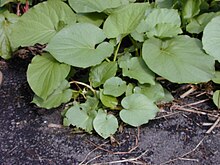| Piper auritum | |
|---|---|

| |
| Scientific classification | |
| Kingdom: | Plantae |
| Clade: | Tracheophytes |
| Clade: | Angiosperms |
| Clade: | Magnoliids |
| Order: | Piperales |
| Family: | Piperaceae |
| Genus: | Piper |
| Species: | P. auritum |
| Binomial name | |
| Piper auritum Kunth | |
| Synonyms | |
|
Piper sanctum | |
Piper auritum is an aromatic culinary herb in the pepper family Piperaceae, which grows in tropical Central America. Common names include hoja santa (Spanish for 'sacred leaf'), yerba santa, hierba santa, Mexican pepperleaf, acuyo, tlanepa, anisillo, root beer plant, Vera Cruz pepper and sacred pepper.
Description
It is a perennial herbaceous plant up to nineteen feet (six meters) in height with heart-shaped velvety leaves. The leaves can reach up to 30 centimeters (12 in) or more in size. The flowers are in simple white spikes containing myriads of tiny florets which rise above the foliage like candles. The entire plant is said to have the fragrance of Sassafras. The complex flavor is not so easily described; it has been compared to eucalyptus, licorice, sassafras, anise, nutmeg, mint, tarragon, and black pepper. The flavor is stronger in the young stems and veins.
It is native to the Americas, from northern South America to Mexico, and is also cultivated in California and southeast Florida.
Use
It is often used in Mexican cuisine in tamales, fish or meat wrapped in its fragrant leaves for cooking, and as an essential ingredient in mole verde, a green sauce originally from the Oaxaca region of Mexico. It is also used to flavor eggs and soups like pozole. In Central Mexico, it is used to flavor chocolate drinks. In southeastern Mexico, a green liquor called verdín is made from hoja santa.
While typically used fresh, it is also used dried, although the drying process removes much of the flavor and makes the leaf too brittle to be used as a wrapper.
Chemistry / constituents
The leaf oil of Piper auritum contains a relatively high concentration of hepatotoxic safrole, around 70%. A few of the other 40 constituents occurring in minor quantities were α-thujene, α-pinene, camphene, β-pinene, myrcene, and limonene.
References
- ^ Barlow, Prof. Snow (2003). "Sorting Piper names". University of Melbourne. Retrieved 2007-03-29.
- ^ Rolland, Jacques L. (2006). The Food Encyclopedia: Over 8,000 Ingredients, Tools, Techniques and People. Robert Rose. p. 326. ISBN 0-7788-0150-0.
- ^ Miller, Mark Charles (1993). Coyote's Pantry: Southwest Seasonings and at Home Flavoring Techniques. Ten Speed Press. p. 70. ISBN 0-89815-494-4.
- ^ Katzer, Gernot (2012). "Gernot Katzer's Spice Pages - Mexican Pepperleaf (Piper auritum Kunth)". Retrieved 2012-12-03.
- NRCS. "Piper auritum". PLANTS Database. United States Department of Agriculture (USDA). Retrieved 6 October 2015.
- Zuchowski, Willow (2007). Tropical Plants of Costa Rica. Ithaca, N.Y.: Cornell Univ. Press. pp. 64–65. ISBN 0-978-8014-1588-0.
{{cite book}}: Check|isbn=value: invalid prefix (help) - ^ "Ingredient - Hoja Santa". The Washington Post. 2004-08-18. Retrieved 2007-03-29.
- Pyles, Stephan (1999). New Tastes from Texas. Three Rivers Press. p. 214. ISBN 0-609-80497-9.
- Raichlen, Steven (2000). Steven Raichlen's Healthy Latin Cooking: 200 Sizzling Recipes from Mexico, Cuba, Caribbean, Brazil, and Beyond. Rodale Books. p. 26. ISBN 0-87596-498-2.
- Lambert, Paula (2000). The Cheese Lover's Cookbook and Guide: Over 150 Recipes with Instructions on How to Buy, Store, and Serve All Your Favorite Cheeses. Simon & Schuster. p. 43. ISBN 0-684-86318-9.
- Davidson, Alan (1999). The Oxford Companion to Food. Oxford University Press. p. 383. ISBN 0-19-211579-0.
- Hale, Adrian J.S. (2006-09-28). "Craft, not Kraft, is the key to these homeland treats". Orlando Weekly. Archived from the original on 2006-11-14. Retrieved 2007-03-29.
- Nordin, Donna (2001). Contemporary Southwest: The Cafe Terra Cotta Cookbook. Ten Speed Press. p. 19. ISBN 1-58008-180-0.
- Creasy, Rosalind (2000). The Edible Mexican Garden. Tuttle Publishing. p. 35. ISBN 962-593-297-6.
- Conner, Lori (2006). "El Restaurante Mexicano (May/June 2006): Beyond margaritas". Maiden Name Press LLC. Archived from the original on 2007-04-20. Retrieved 2007-04-01.
- Bladholm, Linda (2001). Latin & Caribbean Grocery Stores Demystified. Renaissance Books. p. 106. ISBN 1-58063-212-2.
- Gupta, Mahabir P.; Arias, Tomás D.; Williams, Norris H.; Bos, R.; Tattje, D. H. E. (March 1985). "Safrole, the Main Component of the Essential Oil from Piper auritum of Panama". Journal of Natural Products. 48 (2): 330–330. doi:10.1021/np50038a026.
External links
| Traditional biodegradable culinary wrappings, beddings, layering & dishware | ||
|---|---|---|
| Latin America |  | |
| Asia |
| |
| Africa | ||
| As dishware | ||
| Taxon identifiers | |
|---|---|
| Piper auritum |
|